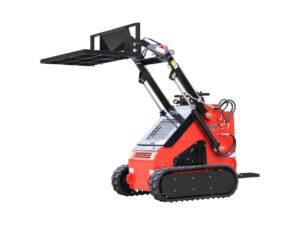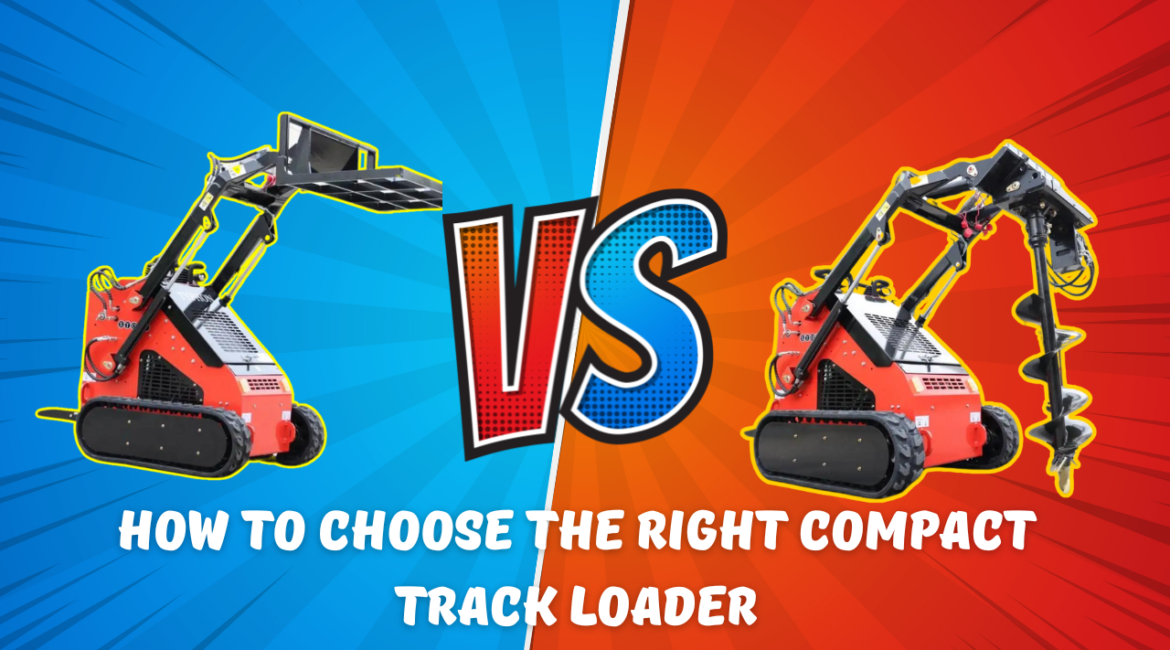How to Choose the Right Compact Track Loader for Your Project: A Comprehensive Guide
Whether a project is in construction, landscaping, farming, or any sector that calls for heavy-duty equipment, the success of every project depends on choosing the correct compact track loader (CTL). Given the abundance of choices now available, it can be difficult to identify the ideal CTL. The knowledge in this **How to Choose the Right Compact Track Loader** will help you to find the most appropriate CTL for your particular requirements.
Comprehending Compact Track Loaders: What Are They?
Compact track loaders are devices that are both powerful and versatile, as they are equipped with tracks rather than wheels. They are intended to execute a diverse array of duties, such as material handling, grading, lifting, and digging, on a variety of terrains. CTLs are in high demand in the construction, agriculture, and landscaping industries because of their capacity to function in challenging environments, including dirt, snow, and uneven terrain.

The Importance of Selecting the Appropriate Compact Track Loader
The efficiency, safety, and overall cost-effectiveness of your project are all directly influenced by the selection of the appropriate CTL. A machine that is carefully selected will guarantee that tasks are completed in a timely and efficient manner, thereby reducing operational costs and outages. In contrast, an inadequate CTL may result in equipment wear and tear, delays, and potential safety hazards.
Key Factors to Take into Account When Selecting a Compact Track Loader
Several critical factors must be taken into account when selecting the appropriate compact track compactor for your project:
1. Comprehend the Specifications of Your Project
It is essential to have a comprehensive comprehension of the requirements of your project before delving into the specifications of various CTLs. Consider the subsequent enquiries:
- What manner of work will the CTL be responsible for? Knowing the specific tasks, whether you are grading land, transporting materials, or digging trenches, will assist you in reducing your options.
- What does the terrain resemble? A CTL with tracks that are engineered to provide the highest level of stability and traction is necessary
- when operating on soft, irregular, or muddy terrain.
- What are the limitations on the dimensions of the object? Take into account the extent of the worksite. In urban environments or cramped spaces, it may be necessary to employ a compactor that is more compact.
2. Assess the Performance and Power
The overall efficacy of a compact track loader is determined by the engine power and hydraulic flow rate. What to seek is as follows:
- Horsepower (HP): The capacity of a CTL to execute heavy-duty duties is determined by its horsepower. For more demanding tasks, such as the transportation of substantial quantities of material or the operation of hefty attachments, it is imperative to have a higher horsepower.
- Rated Operating Capacity (ROC): The ROC is a measure of the utmost load that a CTL can safely lift. Ensure that the ROC is in accordance with the weight specifications of the materials you will be handling.
- Hydraulic Flow: This is essential for the operation of attachments such as hydraulic breakers, trenchers, or augers. More demanding attachments can be effectively powered by machines with high-flow hydraulic systems.
3. Evaluate the Durability and Design of the Track
CTLs are distinguished by their tracks, which offer superior stability and propulsion in comparison to wheeled loaders. When conducting an assessment of track design, it is important to take into account
- Track Width: The machine’s weight is distributed more evenly by wider tracks, which reduces ground pressure and increases stability, particularly on soft or irregular terrain.
- Rubber tracks are a prevalent choice for CTLs, as they provide a harmonious combination of flexibility and durability. Maximise the lifespan of the tracks by reinforcing them.
- Undercarriage Design: The tracks are supported by the undercarriage, which must be sufficiently durable to withstand the demands of your worksite. It is important to determine whether a rigid undercarriage is necessary for maximum durability or a suspended undercarriage for enhanced ride comfort.
4. Evaluate the Machine’s Dimensions and Weight
Especially if your endeavor necessitates working on weight-sensitive surfaces or in confined spaces, the size and weight of the CTL are crucial.
- Machine Dimensions: Compact dimensions are indispensable for operating in urban environments or navigating restricted spaces.
- Nevertheless, it is imperative that the machine’s stability and lifting capacity are not jeopardised by its dimensions.
- Operating Weight: The mobility and ground pressure of the CTL are influenced by its weight. While a heavier machine may provide greater stability, it may also result in increased ground disturbance.
5. Verify the compatibility of the attachments.
One of the most significant benefits of CTLs is their capacity to utilise a diverse array of attachments, rendering them a versatile utility. Take into account the subsequent:
- Attachment Availability: Verify the availability of attachments that are compatible with the CTL. Attachments that are frequently utilised include buckets, augers, trenchers, prongs, and grapples.
- Systems for Rapid Attachment: Guarantee that the CTL is furnished with a quick attach system that enables the rapid and effortless exchange of attachments, thereby increasing productivity.
6. Evaluate the Operator Safety and Comfort Features
Operator safety and comfort are of the utmost importance, particularly during extended workdays. Search for:
- Cab Design: A cab that is well-designed, features ergonomic controls, air conditioning, and great visibility, which improves operator comfort and reduces fatigue.
- Safety Features: Ensure that the CTL is equipped with critical safety features, including automatic termination systems, backup
- cameras, seat belts, and rollover protection structures (ROPS), in the event of an emergency.
7. Evaluate the Manufacturer’s Support and Reputation
A reliable machine with excellent customer support is guaranteed when you select a CTL from a reputable manufacturer. Assess:
- Brand Reputation: To evaluate the reliability and efficacy of the brand’s machines, consult customer reviews and ratings.
- Service and Warranty: Verify the warranty terms and the availability of service centres. It is essential to have a reliable warranty and access to service support in order to reduce disruption.
8. Evaluate the Environmental Impact and Fuel Efficiency
Fuel efficiency is an essential factor to consider in light of the escalating costs of fuel and the growing environmental concerns.
- Efficiency in Fuel Consumption: Select a CTL that consumes fuel efficiently in order to decrease operational expenses over time.
- Emissions Compliance: Particularly if you are conducting business in regions with stringent environmental regulations, guarantee that the machine adheres to the most recent emissions standards.
9. Budgetary Factors
Ultimately, your decision will be significantly influenced by your budget. Take into account:
- Long-term Value vs. Initial Cost: Consider the long-term value in terms of durability, performance, and maintenance costs, even if it is alluring to select a less expensive machine.
- Financing Options: If necessary, investigate financing alternatives. Many manufacturers and dealers provide leasing or financing programs to reduce the cost of purchasing a CTL.
Top Compact Track Loader Brands to Consider
Some of the most prominent compact track loader manufacturers, which are recognized for their reliability, performance, and support, are as follows:
When it comes to investing in a compact track loader (CTL), choosing the right brand is crucial for ensuring long-term reliability and performance. Among the top brands, TYPHON Machinery stands out for its exceptional quality and innovation. TYPHON Machinery’s CTLs are designed to tackle the toughest jobs with ease, offering unmatched durability and efficiency.
TYPHON Machinery’s compact track loaders are engineered with advanced features that enhance productivity, whether you’re working in construction, landscaping, or agriculture. Their machines are known for their powerful engines, precise control, and versatile attachment options, making them ideal for a wide range of applications.
Moreover, TYPHON Machinery prioritizes operator comfort and safety, with ergonomically designed cabs and state-of-the-art safety features that ensure a smooth and secure operation. Their commitment to quality is evident in every detail, from the robust undercarriage to the user-friendly controls.
For those looking to invest in a compact track loader that delivers both power and precision, TYPHON Machinery offers a range of models to meet your needs. Visit TYPHON Machinery to explore their selection and find the perfect CTL for your next project.
Conclusion: Selecting the Appropriate Option for Your Project
The selection of the appropriate compact track loader necessitates a meticulous evaluation of the machine’s capabilities, the specific requirements of your project, and your budget. By assessing factors such as capacity, track design, attachment compatibility, and brand reputation, you can guarantee that you choose a CTL that will optimise productivity and reduce expenses.
The success of your project can be significantly impacted by the selection of the appropriate compact track loader, regardless of whether you are engaged in construction, landscaping, or agriculture. Invest the necessary time to evaluate your alternatives, consult with professionals, and make an informed decision that is consistent with the objectives of your undertaking.
Visit [Your Company’s Website] today to learn more about selecting the optimal compact track loader for your requirements or to investigate a diverse selection of high-quality CTLs. Our team is available to assist you in identifying the ideal machine for your forthcoming endeavour.

